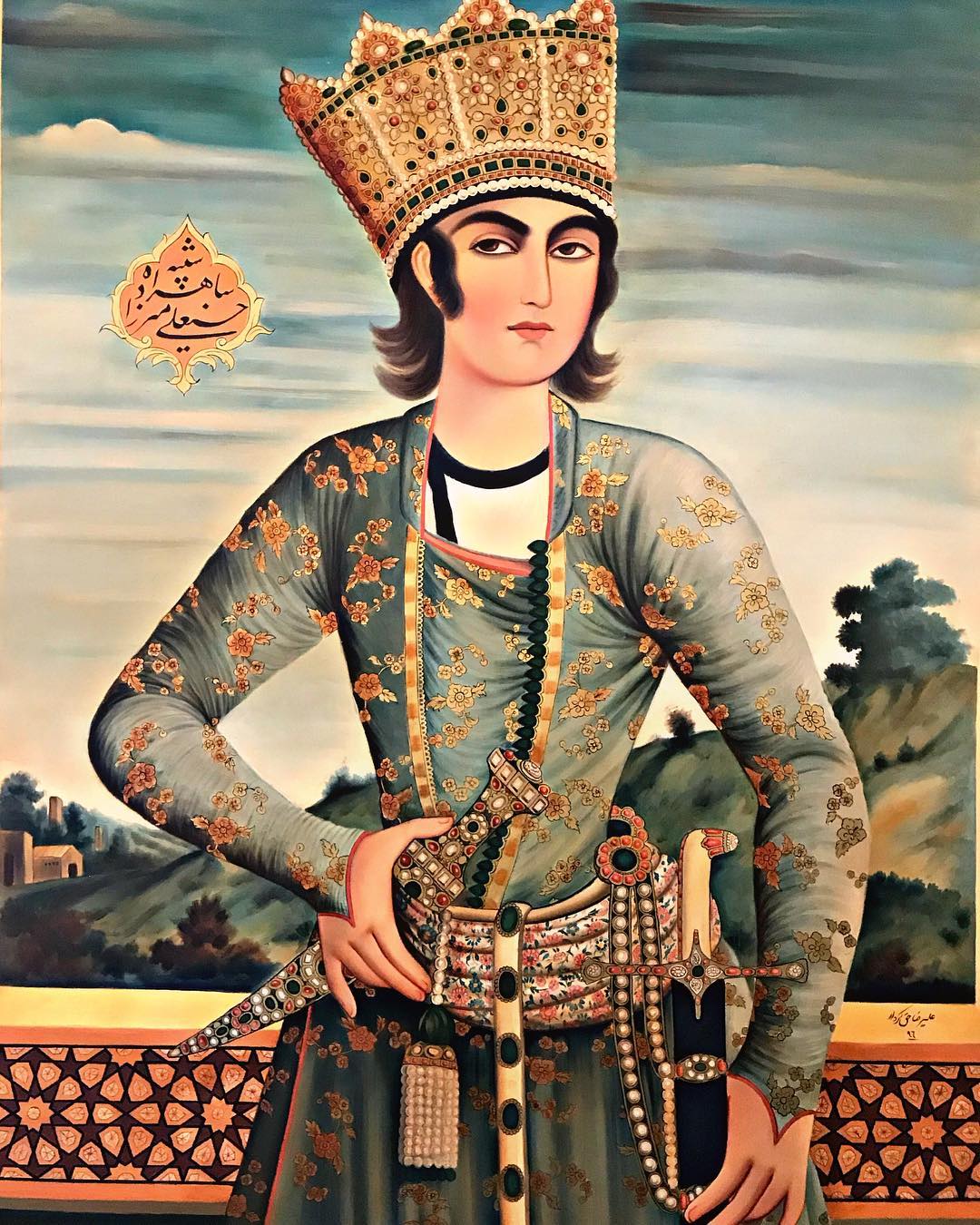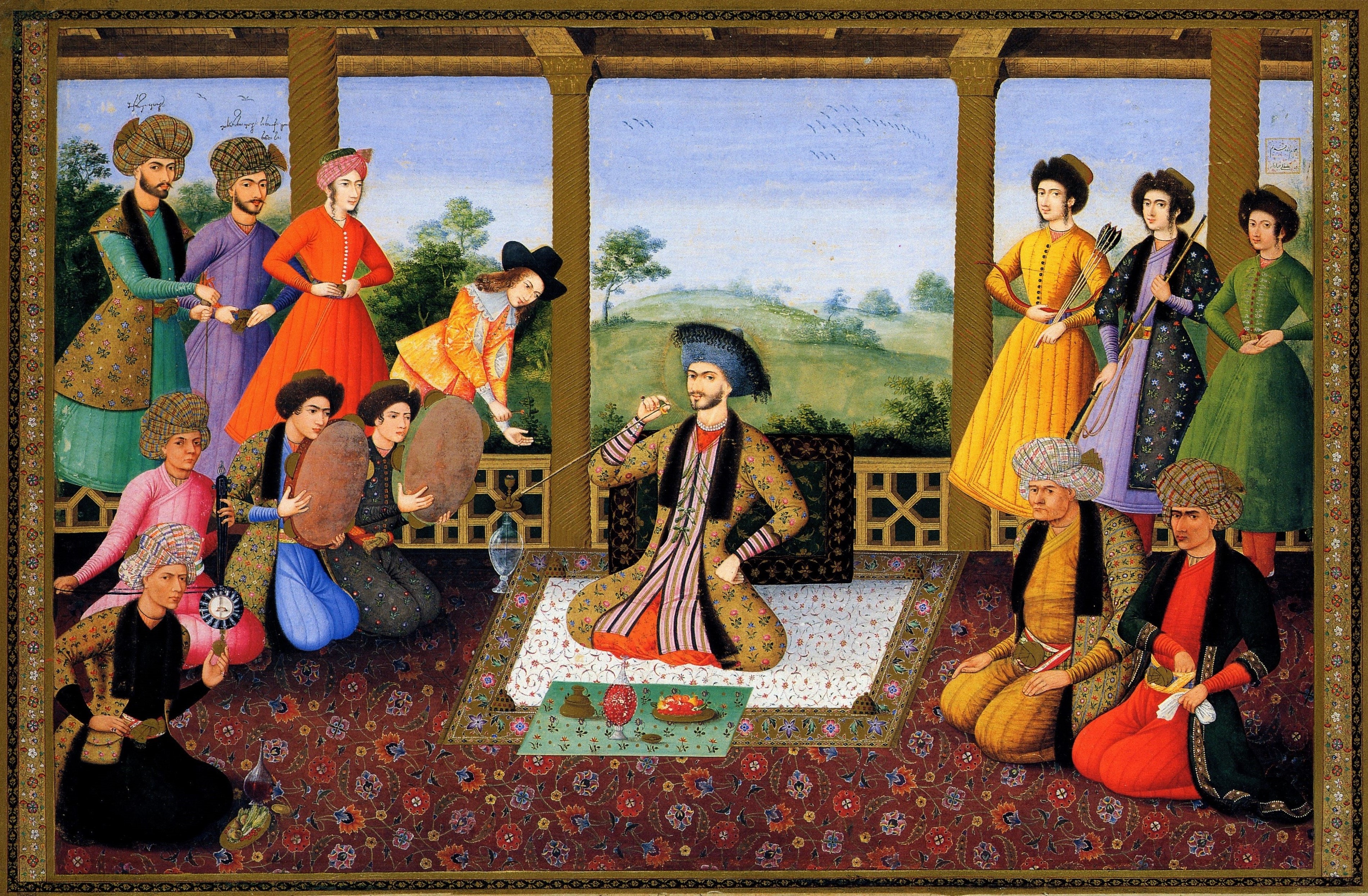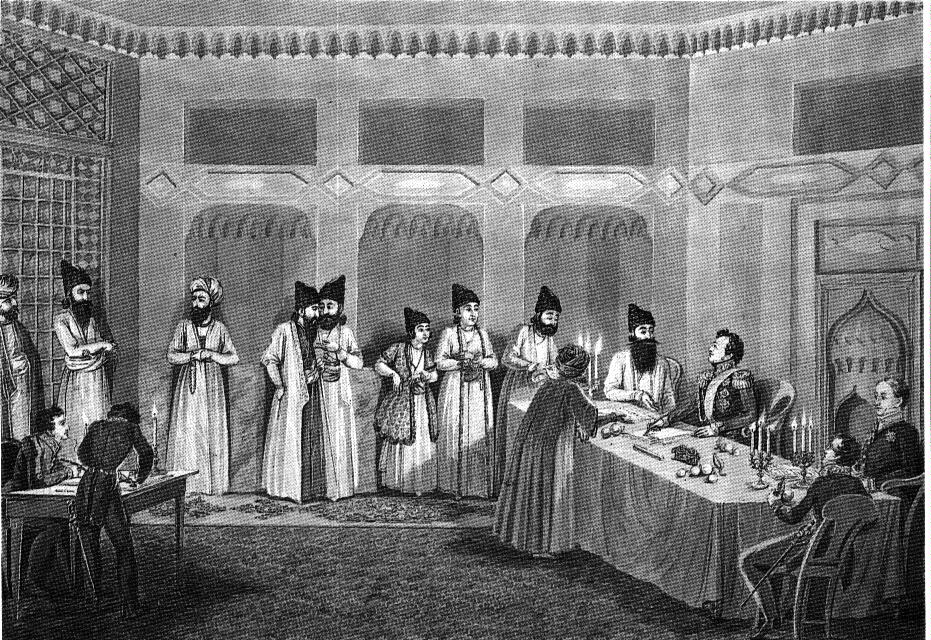|
Dowlatshah
Mohammad Ali Mirza Dowlatshah (4 January 1789, in Nava – 22 November 1821, in Taq-e Gara) was a famous Iranian Prince of the Qajar dynasty. He is also the progenitor of the Dowlatshahi Family of Persia. He was born at Nava, in Mazandaran, a Caspian province in the north of Iran. He was the first son of Fath-Ali Shah, the second Qajar king of Persia, and Ziba Chehr Khanoum, a Georgian girl of the Tsikarashvili family. He was also the elder brother (by seven months) of Abbas Mirza. Dowlatshah was the governor of Fars at age 9, Qazvin and Gilan at age 11, Khuzestan and Lorestan at age 16, and Kermanshah at age 19. In the battles with Russia and Persia's archrival, the Ottoman Empire, he defeated the Ottomans in Baghdad and Basra, and crushed the Russians in Yerevan and Tbilisi. Dowlatshah developed and improved the city of Kermanshah and established the city of Dowlat-Abad which was renamed Malayer. Dowlatshah had 10 sons. His descendants live in various countries around the wo ... [...More Info...] [...Related Items...] OR: [Wikipedia] [Google] [Baidu] |
Fath-Ali Shah Qajar
Fath-Ali Shah Qajar ( fa, فتحعلىشاه قاجار, Fatḥ-ʻAli Šâh Qâjâr; May 1769 – 24 October 1834) was the second Shah (king) of Qajar Iran. He reigned from 17 June 1797 until his death on 24 October 1834. His reign saw the irrevocable ceding of Iran's northern territories in the Caucasus, comprising what is nowadays Georgia, Dagestan, Azerbaijan, and Armenia, to the Russian Empire following the Russo-Persian Wars of 1804–1813 and 1826–1828 and the resulting treaties of Gulistan and Turkmenchay. Historian Joseph M. Upton says that he "is famous among Iranians for three things: his exceptionally long beard, his wasp-like waist, and his progeny." At the end of his reign, his difficult economic problems and military and technological liabilities took Iran to the verge of governmental disintegration, which was quickened by a consequent struggle for the throne after his death. Under Fath-Ali Shah, many visual portrayals of himself and his court were created i ... [...More Info...] [...Related Items...] OR: [Wikipedia] [Google] [Baidu] |
Kermanshah
Kermanshah ( fa, کرمانشاه, Kermânšâh ), also known as Kermashan (; romanized: Kirmaşan), is the capital of Kermanshah Province, located from Tehran in the western part of Iran. According to the 2016 census, its population is 946,681 (2021 estimate 1,047,000). A majority of the people of Kermanshah are bilingual in Southern Kurdish and Persian, and the city is the largest Kurdish-speaking city in Iran. Kermanshah has a moderate and mountainous climate.روزنامه سلام کرمانشاه Persian (Kurdish)آشنایی با فرهنگ و نژاد استان کرمانشاه (Persian) [...More Info...] [...Related Items...] OR: [Wikipedia] [Google] [Baidu] |
Hossein Ali Mirza
Hossein Ali Mirza (; 26 August 1789 – 16 January 1835), a son of Fath-Ali Shah (1797–1834), was the Governor of Fars and pretender to the throne of Qajar Iran. As governor, Ali Mirza restored Shah Cheragh. He opened the tombs of the Achaemenid kings to obtain gold, but found them empty. During his rule, the city of Shiraz was subjected to high taxation and low security. Ali Mirza gained independence from the government of Hajji Mohammad Hossein Isfahani, rented Bushehr ports to the British and stopped paying taxes after 1828, thus going 200,000 tomans in tax arrears to the crown. After Fath-Ali Shah's death, Prince Mohammad Mirza was crowned shah (king) as Mohammad Shah Qajar, but Ali Mirza formerly as the fifth in line for the throne, led a revolt and entitled himself as Hossein Ali Shah. After two months he was defeated in Shiraz by Manouchehr Khan Gorji. On the orders of Mohammad Shah, Ali Mirza was blinded and imprisoned in Ardabil, where he died of cholera in Janu ... [...More Info...] [...Related Items...] OR: [Wikipedia] [Google] [Baidu] |
Iranian Georgians
Iranian Georgians or Persian Georgians ( ka, ირანის ქართველები; fa, گرجیهای ایران) are Iranian citizens who are ethnically Georgian, and are an ethnic group living in Iran. Today's Georgia was subject to Iran in the ancient times under the Achaemenid and Sassanian empires and from the 16th century till the early 19th century, starting with the Safavids in power and later Qajars. Shah Abbas I, his predecessors, and successors, relocated by force hundreds of thousands of Christian, and Jewish Georgians as part of his programs to reduce the power of the Qizilbash, develop industrial economy, strengthen the military, and populate newly built towns in various places in Iran including the provinces of Isfahan, Mazandaran and Khuzestan. A certain number of these, among them members of the nobility, also migrated voluntarily over the centuries, as well as some that moved as muhajirs in the 19th century to Iran, following the Russian conqu ... [...More Info...] [...Related Items...] OR: [Wikipedia] [Google] [Baidu] |
English Language
English is a West Germanic language of the Indo-European language family, with its earliest forms spoken by the inhabitants of early medieval England. It is named after the Angles, one of the ancient Germanic peoples that migrated to the island of Great Britain. Existing on a dialect continuum with Scots, and then closest related to the Low Saxon and Frisian languages, English is genealogically West Germanic. However, its vocabulary is also distinctively influenced by dialects of France (about 29% of Modern English words) and Latin (also about 29%), plus some grammar and a small amount of core vocabulary influenced by Old Norse (a North Germanic language). Speakers of English are called Anglophones. The earliest forms of English, collectively known as Old English, evolved from a group of West Germanic (Ingvaeonic) dialects brought to Great Britain by Anglo-Saxon settlers in the 5th century and further mutated by Norse-speaking Viking settlers starting in the 8th and 9th ... [...More Info...] [...Related Items...] OR: [Wikipedia] [Google] [Baidu] |
Abbas Mirza
Abbas Mirza ( fa, عباس میرزا; August 26, 1789October 25, 1833) was a Qajar crown prince of Iran. He developed a reputation as a military commander during the Russo-Persian War of 1804–1813 and the Russo-Persian War of 1826–1828, as well as through the Ottoman–Persian War of 1821–1823. He is furthermore noted as an early modernizer of Persia's armed forces and institutions, and for his death before his father, Fath Ali Shah. Abbas was an intelligent prince, possessed some literary taste, and is noteworthy on account of the comparative simplicity of his life. With Abbas Mirza as the military commander of the Persian forces, Iran lost all of its territories in the Caucasus comprising the South Caucasus and parts of the North Caucasus (Dagestan) to Russia in conformity with the 1813 Treaty of Gulistan and the 1828 Treaty of Turkmenchay, following the outcomes of the 1804–1813 and 1826–1828 wars. Biography Abbas Mirza was born on August 26, 1789 in Nava, Maz ... [...More Info...] [...Related Items...] OR: [Wikipedia] [Google] [Baidu] |
Yerevan
Yerevan ( , , hy, Երևան , sometimes spelled Erevan) is the capital and largest city of Armenia and one of the world's List of oldest continuously inhabited cities, oldest continuously inhabited cities. Situated along the Hrazdan River, Yerevan is the administrative, cultural, and industrial center of the country, as its primate city. It has been the Historical capitals of Armenia, capital since 1918, the Historical capitals of Armenia, fourteenth in the history of Armenia and the seventh located in or around the Ararat Plain. The city also serves as the seat of the Araratian Pontifical Diocese, which is the largest diocese of the Armenian Apostolic Church and one of the oldest dioceses in the world. The history of Yerevan dates back to the 8th century BCE, with the founding of the fortress of Erebuni Fortress, Erebuni in 782 BCE by King Argishti I of Urartu, Argishti I of Urartu at the western extreme of the Ararat Plain. Erebuni was "designed as a great administrative an ... [...More Info...] [...Related Items...] OR: [Wikipedia] [Google] [Baidu] |
Tbilisi
Tbilisi ( ; ka, თბილისი ), in some languages still known by its pre-1936 name Tiflis ( ), is the Capital city, capital and the List of cities and towns in Georgia (country), largest city of Georgia (country), Georgia, lying on the banks of the Kura (Caspian Sea), Kura River with a population of approximately 1.5 million people. Tbilisi was founded in the 5th century Anno Domini, AD by Vakhtang I of Iberia, and since then has served as the capital of various Georgian kingdoms and republics. Between 1801 and 1917, then part of the Russian Empire, Tiflis was the seat of the Caucasus Viceroyalty (1801–1917), Caucasus Viceroyalty, governing both the North Caucasus, northern and the Transcaucasia, southern parts of the Caucasus. Because of its location on the crossroads between Europe and Asia, and its proximity to the lucrative Silk Road, throughout history Tbilisi was a point of contention among various global powers. The city's location to this day ensures its p ... [...More Info...] [...Related Items...] OR: [Wikipedia] [Google] [Baidu] |
French Language
French ( or ) is a Romance language of the Indo-European family. It descended from the Vulgar Latin of the Roman Empire, as did all Romance languages. French evolved from Gallo-Romance, the Latin spoken in Gaul, and more specifically in Northern Gaul. Its closest relatives are the other langues d'oïl—languages historically spoken in northern France and in southern Belgium, which French ( Francien) largely supplanted. French was also influenced by native Celtic languages of Northern Roman Gaul like Gallia Belgica and by the ( Germanic) Frankish language of the post-Roman Frankish invaders. Today, owing to France's past overseas expansion, there are numerous French-based creole languages, most notably Haitian Creole. A French-speaking person or nation may be referred to as Francophone in both English and French. French is an official language in 29 countries across multiple continents, most of which are members of the ''Organisation internationale de la Francophonie'' ... [...More Info...] [...Related Items...] OR: [Wikipedia] [Google] [Baidu] |
Ottoman Iraq
Ottoman Iraq ( ar, العراق العثماني}) refers to the period of the history of Iraq when the region was ruled by the Ottoman Empire (1534–1920; with an interlude from 1704 to 1831 of autonomy under the Mamluk dynasty of Iraq).Before reforms (1534–1704), Iraq was divided into four Eyalets (provinces): * Baghdad Eyalet * Shahrizor Eyalet * Basra Eyalet * Mosul Eyalet Ottoman Iraq was later (1831–1920) divided into the three vilayets (provinces): * Mosul Vilayet * Baghdad Vilayet * Basra Vilayet During World War I, an invasion of the region was undertaken by British Empire forces and was known as the Mesopotamian campaign. Fighting commenced with the Battle of Basra in 1914 and continued for the duration of the war. The most notable action was the siege of Kut, which resulted in the surrender of the British and British Indian Army garrison of the town in April 1916, after a siege of 147 days. Contemporary maps, showing eyalets (pre Tanzimat reforms) Contempo ... [...More Info...] [...Related Items...] OR: [Wikipedia] [Google] [Baidu] |
Polish Language
Polish (Polish: ''język polski'', , ''polszczyzna'' or simply ''polski'', ) is a West Slavic language of the Lechitic group written in the Latin script. It is spoken primarily in Poland and serves as the native language of the Poles. In addition to being the official language of Poland, it is also used by the Polish diaspora. There are over 50 million Polish speakers around the world. It ranks as the sixth most-spoken among languages of the European Union. Polish is subdivided into regional dialects and maintains strict T–V distinction pronouns, honorifics, and various forms of formalities when addressing individuals. The traditional 32-letter Polish alphabet has nine additions (''ą'', ''ć'', ''ę'', ''ł'', ''ń'', ''ó'', ''ś'', ''ź'', ''ż'') to the letters of the basic 26-letter Latin alphabet, while removing three (x, q, v). Those three letters are at times included in an extended 35-letter alphabet, although they are not used in native words. The traditional ... [...More Info...] [...Related Items...] OR: [Wikipedia] [Google] [Baidu] |






